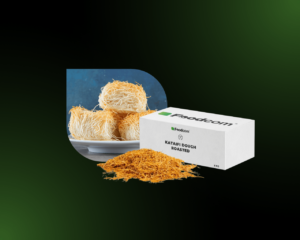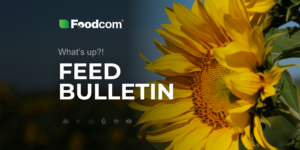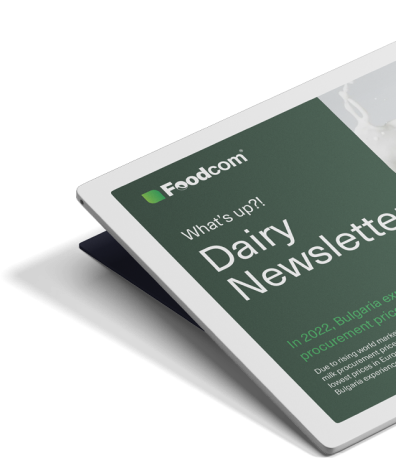- Cocoa prices have reached a historic high due to climate change, disease and limited supply from West Africa.
- The growing interest in colostrum is met with its limited availability, which drives up prices and intensifies competition.
- The European Union is introducing a 25% tariff on US corn, which could significantly increase costs in the feed sector.
- EU butter prices are falling under pressure from competition from Ukraine, despite a seasonal increase in production and the risk of animal diseases.
Cocoa prices are reaching new peaks, egg powder is gaining momentum and the limited supply of colostrum is driving competition. With changing tariffs, pressure on butter and new health risks in Europe, April brings key developments to watch. For the full picture, see Foodcom S.A.’s latest market bulletin.
Cocoa
The cocoa market is under immense pressure, with commodity prices reaching record levels due to climate change, plant diseases and limited supply from West Africa (70% of the world harvest). Ghana, unlike Côte d’Ivoire (where farmgate prices have risen by 22%), has kept rates unchanged, which could affect growers’ decisions and export stability. In addition, the tariffs introduced – 10% for Ghana and 21% for Côte d’Ivoire – are increasing costs and reducing the profitability of trade. Barry Callebaut is already feeling the effects: the company has lowered its sales forecasts and its shares fell by a record 20% in one day – the biggest one-day drop in the company’s history.
Colostrum
Colostrum, or colostrum extracted in the first few days after calf birth, is gaining popularity in the supplements, cosmetics and health-enhancing products sector thanks to its unique properties – supporting immunity, body regeneration and the balance of intestinal microflora. However, the growing demand driven by the trend towards natural ingredients is met with limited availability of the raw material, which can only be sourced for a very short time. This makes colostrum a seasonal raw material, requiring precise logistics and high ethical standards. As a result, colostrum prices are hitting record highs and competition for raw material is steadily increasing, affecting the cost of final products.
Take a look at the recommended article to learn more: Colostrum – the extraordinary power of bovine colostrum. Why take an interest in its properties?
Butter
EU butter prices in April 2025 have fallen to 7100-7250 EUR/MT EXW, with competitive offers from Ukraine (6800-6900 EUR/MT) putting additional pressure. Despite the seasonal increase in production, buyers remain cautious and the market is characterised by limited availability of fresh offers. It is worth keeping a close eye on the situation – we are already facing a hydrological drought, which could affect milk supply. In addition, with higher temperatures and improved weather, the return of the blue tongue disease problem in Europe is to be expected.
Eggs
In 2024, the global egg market struggled with limited supply due to avian flu, rising feed and energy costs, leading to record prices, particularly in the US and Europe. In response, the food industry and HoReCa sector are increasingly turning to egg powder – a sustainable, conveniently transportable and more accessible raw material. Its popularity is growing especially in Asia and Latin America, where it is a practical alternative to fresh eggs. Forecasts indicate that this trend will also continue in 2025.
Click for an article worth reading: Overview and analysis of the egg market in 2025 [Global Report]
NEWS
Indonesian palm oil producers’ associations have asked the government to reduce export levies to offset the impact of 32% tariffs imposed by the US on their products. Small producer group SPKS warns that the new tariffs could reduce farmers’ incomes by up to 3%, and they are therefore calling for the complete removal of export taxes and fees, which currently stand at US$196 per metric tonne. In contrast, the largest industry association, GAPKI, is proposing a targeted cost reduction of US$100 per tonne for shipments to the US to remain competitive with Malaysian exporters who have lower export costs. In 2023, the US accounted for 7% of Indonesian palm oil export volumes and revenues, making this market important for producers there.
Hungarian authorities are investigating the causes of the country’s first case of foot-and-mouth disease in more than 50 years, which has led to the mass slaughter of cattle and the closure of border crossings with Austria and Slovakia. The head of the prime minister’s office, Gergely Gulyás, suggested at a press conference that it could not be ruled out that the virus had been deliberately introduced, suggesting the possibility of a ‘biological attack’. However, he stressed that these suspicions are based on preliminary information from a foreign laboratory and require further confirmation. At present, there have been no new outbreaks of the disease and the authorities are continuing their eradication efforts.
From 15 April 2025, the European Union is imposing 25% tariffs on maize imports from the US, in response to US tariffs on steel and aluminium. The decision could significantly reduce the influx of cheaper US maize, which benefits the European feed sector. From July 2024 to early April 2025, the EU imported 3.4 million tonnes of maize from the US, a significant increase from 114,000 tonnes in the same period the previous year. Alternative sources, such as Ukraine and Brazil, currently offer more expensive maize, which could increase importers’ costs by around US$6-7 per tonne. Representatives of the European feed industry are concerned that the new tariffs could add around €2 billion to the sector’s costs and are calling for negotiations to avoid an escalation of tariffs. It is worth noting that the tariffs on US soybeans will not come into force until 1 December 2025, giving time for possible trade talks on the issue.
![What’s new in the food industry? Market overview and analysis [April 2025] What’s new in the food industry? Market overview and analysis [April 2025]](https://foodcom.pl/wp-content/uploads/2025/04/biuletyn-food-1520x760.png)






